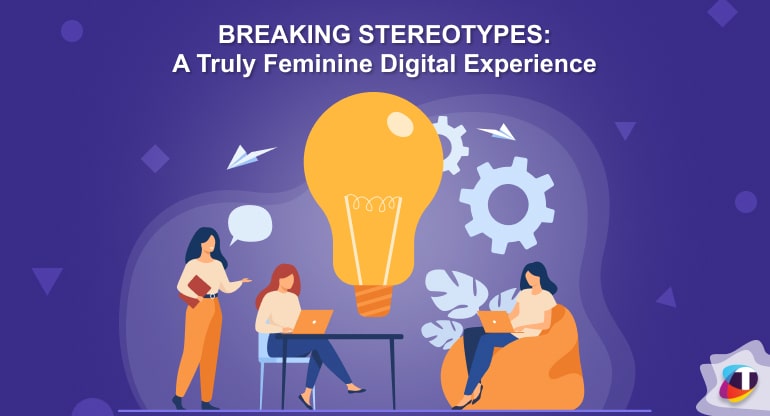Male-dominated internet is a thing of past. Internet has a new user.
Since the introduction of the internet and its widespread use in the world, the digital front has always been catering to the interests of men. Most websites and applications back then revolved around the interests of men so much so that over 87% of the internet users till mid-2000s were men. Nevertheless, with the emerging technological advancements and increased exposure of women to digital experience, women web-users have taken the lead as the key group on the cyberspace. But the main question remains- is the digital arena ready to welcome this new target group yet?
In this blog, we will explore the various aspects of the internet with regards to female users and how the digital experience can be tailored for a feminine experience. Let’s dig in!
Female Internet Users in the Past Decade
Although there are still wide disparities between female web users in different regions worldwide. On one hand, the number of female internet users in Africa has been stagnant at 22.6% while on the other hand, the female internet users in America has been a staggering 76.8%.
The paradigm shift of the web userbase towards women’s interests has been pretty evident. While in the early 2000s, where the gender-based user difference stood at over 50% to 70%, today, the void has been filled to witness the maximum difference of 10.2% (Africa).
Globally, women have turned to the internet as a primary source in various facets of life including entertainment, earning a livelihood, information collection, and much more.
Stereotypes Associated with Feminine Digital Experience
‘Pink is for girls’, ‘Diamonds are a girl’s best friend’, ‘She is emotional and vulnerable’- all these stereotypes are as prevalent in the digital experience as in the real world.
When it comes to tailoring the digital experience for women, we instantly think of the stereotypes associated with females. Additionally, if we bring ourselves to think of the content consumption of women on the internet, the first options that pop up in our minds are makeup, photography, and shopping. Truth be told, women have a much larger share of content consumption on other fields such as information consumption, digital marketing, and even contribute largely in creating content online.
Unfortunately, creating a women-centric digital experience still follows the lines of these stereotypes. The ‘pink and bling’ idea shows prominently across websites and applications dedicated to women. While it may work to some extent, but including creativity for greater inclusiveness is something to be pondered upon.
Breaking Stereotypes: A Truly Feminine Digital Experience

When it comes to User Experience or UX, stereotyping might end up straying you away from the goal of traffic generation. Women on the internet are far off from their stereotypes. It might not be fruitful to stick to the typical UI in welcoming the female users. In fact, the more gender-neutral UI witness greater response from this new group of users.
With that being said, there are a few ways how you can tailor the digital experience for females and get greater response from this particular group.
Color Scheme
Pinks and reds are the first choices while creating a women-centric digital interface. What we often forget to consider is the tones and hues. The floodgates to a greater and more attractive color pallet opens up as soon as you broaden your horizon. Some of the preferable options include shades of purple, yellow, orange, green, and more.
Additionally, pastel colors have become a popular choice among females in recent times. Using pastel shades in the interface will not only be attractive but also give a very clean and structured feel to the interface. Sparely using golden and silver colors can create a luxurious experience but it should be well-placed to fulfill the intent.
White Space
White space is always an important element of designing. When it comes to creating a digital experience for females, this is a rather vital aspect. Women are predominantly inclined towards clean and chic appearance- a scientific fact. Using white space in the right moderation can impart a polished feel.
Content and Intent
Women are now proactively consuming content across the vast expanses of the internet. Right from online shopping to e-commerce, to e-gaming, females consume all kinds of content. Resultantly, there are no specific fields that can be associated specifically with only women, or no fields that they won’t use.
On some websites, it is preferable to induce inclusiveness over gender-based customizations. To the contrary, some websites such as e-commerce websites for makeup products or women apparels need to focus exclusively on their target group. In such cases, it is recommended to keep the content available on the website or application predominantly women-centric and informative at the same time. Including out-of-the-box ideas is vital to attract new users and avoid redundancy on the internet. One of the key features highlighted today is inclusiveness. While representing a brand for women, it is a power-move to include all skin colors, skin types, body types, etc. Women all across the world are digging it lately.
Ask Them
The best way to determine what the users want to see is to ask them. It is a good idea to conduct surveys among current users of a particular website or general women users. Researching online using available data might also be useful. You might be able to unfold some valuable insights through these studies that will help you create the best feminine digital experience.
Conclusively, creating a feminine digital experience is not a tough job as long as you know your audience. The key elements, as mentioned in this blog, can help you unravel a space of true feminine spirit and attract female users from far and wide.
To build just the right user experience for your audience, get in touch with us!
Author :
Mr. Mohar V
CEO & Co-Founder
TECHVED Consulting (I) PVT. LTD.
>> Digital Transformation




